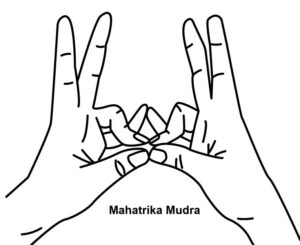Mahatrika Mudra
Introduction
Mahatrika Mudra is a lesser-known but profound yogic hand gesture practiced in Tantric Yoga and Mudra Therapy traditions. The word Trika is associated with the threefold principle—body, mind, and spirit—or sometimes the three primary energies (gunas). The prefix Maha indicates that this mudra deals with the great union of these three forces.
It is mainly practiced to balance the three doshas (Vata, Pitta, Kapha), regulate the three main nadis (Ida, Pingala, Sushumna), and harmonize the three gunas (Sattva, Rajas, Tamas). It is considered a balancing and integrative mudra.
Meaning
Maha = Great
Trika = Threefold (body, mind, spirit / Ida, Pingala, Sushumna / Vata, Pitta, Kapha)
Mudra = Gesture, seal
Thus, Mahatrika Mudra means the great gesture of threefold balance, symbolizing unity of energy, consciousness, and matter.
How to Perform (Practice)
Sit in Padmasana, Sukhasana, or Vajrasana with a straight spine.
Relax the body and take a few deep breaths.
Extend both little fingers and bring the tips together.
Join the ends of the thumbs and index fingers of each hand, and then connect them. Allow your ring and middle fingers to be straight but relaxed.
Rotate your hands slightly so that the ring, middle and little fingers point downward. Hold for as long as feels comfortable.
Practice for 10–20 minutes daily.
Benefits
Physical Benefits
Balances nervous, respiratory, and circulatory systems.
Helps in reducing stress-related disorders.
Supports immune system balance by harmonizing doshas.
Relieves chronic fatigue and body-mind imbalance.
Energetic Benefits
Balances Ida (moon), Pingala (sun), and Sushumna (central) nadis.
Harmonizes three doshas (Vata, Pitta, Kapha).
Activates Ajna Chakra for clarity and intuition.
Integrates the three gunas into a state of sattvic equilibrium.
Mental & Emotional Benefits
Improves concentration and stability.
Calms overactive thinking.
Brings a sense of centeredness and wholeness.
Useful in managing mood swings and emotional imbalances.
Contraindications
Not to be practiced during severe mental disorders without guidance.
Avoid during high fever or acute infections.
Those with severe neurological conditions should consult a therapist before practice.
Anatomy & Physiology
Engages hand reflex zones connected to the brain, lungs, and nervous system.
Enhances oxygen circulation through rhythmic breathing.
Supports balance between sympathetic and parasympathetic nervous systems.
Helps regulate homeostasis by harmonizing autonomic responses.
Kinesiology
Thumb (Fire) + Index finger (Air) + Ring finger (Earth) → union of metabolic energy, movement, and stability.
Extending middle finger (Ether) and little finger (Water) allows expansion and fluidity.
This creates dynamic balance among all five elements, with emphasis on the triadic unity.
Neurology
Stimulates cortical brain centers related to balance and integration.
Activates vagus nerve pathways, reducing stress response.
Promotes left–right hemisphere synchronization.
Supports mental clarity by improving neuro-electrical balance in cranial regions.
Duration of Practice
10–20 minutes daily, either in one sitting or divided sessions.
Can be practiced during meditation, after pranayama, or when mental clarity is needed.
For therapeutic effects, regular practice for 6–8 weeks is recommended.
Counter Mudra
Prana Mudra → to re-energize if feeling drained.
Apana Mudra → for grounding after extended Mahatrika practice.
Hakini Mudra → for additional mental focus and hemispheric balance.
Conclusion
Mahatrika Mudra is a powerful balancing gesture that harmonizes the threefold principles of life: body–mind–spirit, three doshas, three nadis, and three gunas. By integrating these energies, it helps practitioners experience wholeness, balance, and clarity. This mudra is particularly effective in overcoming stress, restoring equilibrium, and deepening meditation.
FAQ
Q1. What is Mahatrika Mudra mainly used for?
It is used for balancing the three doshas, three nadis, and three gunas, thereby promoting holistic harmony.
Q2. Can beginners practice it?
Yes, it is simple and safe for beginners with no complex hand positions.
Q3. Does it help with anxiety?
Yes, by balancing pranic flow and calming the nervous system, it helps reduce stress and anxiety.
Q4. How is it different from Hakini Mudra?
Hakini Mudra focuses mainly on mental focus and memory, while Mahatrika Mudra emphasizes triadic energy balance (doshas, nadis, gunas).
Q5. Can it be combined with meditation?
Yes, it is best practiced during meditation to harmonize energies at deeper levels.
References
Gertrud Hirschi – Mudras: Yoga in Your Hands.
Swami Satyananda Saraswati – Asana, Pranayama, Mudra, Bandha.
K.S. Joshi – Yoga and Mudras.
Ayurveda and Tantra texts on Trika philosophy and triadic energy balance.
Contemporary research on mudra therapy for nervous system regulation.

